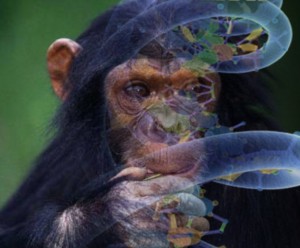 In a letter to Sir Joseph Dalton Hooker, his closest friend in 1857, Charles Darwin confided, “I cannot swallow Man [being that] distinct from a Chimpanzee.” Chimp genetics, by extension of Darwin’s theory, were expected to be similar to humans. Charles Darwin writes in his Autobiography –
In a letter to Sir Joseph Dalton Hooker, his closest friend in 1857, Charles Darwin confided, “I cannot swallow Man [being that] distinct from a Chimpanzee.” Chimp genetics, by extension of Darwin’s theory, were expected to be similar to humans. Charles Darwin writes in his Autobiography –
“My Descent of Man was published in Feb. 1871. As soon as I had become, in the year 1837 or 1838, convinced that species were mutable products, I could not avoid the belief that man must come under the same law.”
The chimp, since the nineteenth century, has been the poster-child missing link to humans. In twenty-first-century terms, the mammalian Y chromosomes were expected to be similar, as speculated by Darwin. However, new evidence demonstrates Darwin’s speculation to be wrong—the chimp Y chromosome differs radically from humans.
Chimp and Human Chromosomes
The chimp, since the nineteenth century, has been the poster-child missing link to humans. In twenty-first-century terms, the mammalian Y chromosomes were expected to be similar, as speculated by Darwin’s theory of natural selection. However, new evidence demonstrates Darwin’s speculation to be wrong—the chimp Y chromosome differs radically from humans.
The British journal Nature published a paper in January 2010 titled, “Chimpanzee and Human Y Chromosomes are Remarkably Divergent in Structure and Gene Content,” which found that Y chromosomes in the chimp and humans “differ radically in sequence structure and gene content.” In fact –
humans “differ radically in sequence structure and gene content.” In fact –
“More than 30% of the chimp Y chromosome lacks an alignable counterpart on the human Y chromosome”
Jennifer F. Hughes (pictured right) led the research team at the Whitehead Institute for Biomedical Research, one of the world’s leading centers for genomic research is located in Cambridge, Massachusetts. The research team concluded –
“By comparing the MSYs of the two species, we show that they differ radically in sequence structure and gene content.”
“By conducting the first comprehensive interspecies comparison of Y chromosomes,” ScienceDaily noted, “Whitehead Institute researchers have found considerable differences in the genetic sequences of the human and chimpanzee Ys… The results overturned the expectation that the chimp and human Y chromosomes would be highly similar. Instead, they differ remarkably in their structure and gene content.”
The original chimp genome sequencing completed in 2005 largely excluded the Y chromosome because its hundreds of repetitive sections had typically confounded standard sequencing techniques. The chimp Y chromosome is only the second Y chromosome to be comprehensively sequenced.
Wes Warren (pictured left), Assistant Director of the Washington University Genome Center, noted – 
“These findings demonstrate that our knowledge of the Y chromosome is still advancing”
Earlier comparative studies between the chimp and human genome had centered on DNA regions that only result in the production of proteins. In addition, not only is the chimp DNA 12% larger than human DNA, the Chimp has 23 chromosomes while humans have only 22 (excluding sex chromosomes in both species).
Implications
While the researchers advance the concept that “divergence” from the Chimp occurred 6 million years ago, the more logical explanation is that the chimp is simply a distinct species. Scientists had anticipated chimp genetics to be similar to human genetics. The genomic revolution, however, has since falsified that theory – intensifying Darwin’s dilemma.
The research was funded by the National Institutes of Health (NIH) and the Howard Hughes Medical Institute (HHMI).
Genesis
 The chromosomal differences observed between humans and apes are compatible with the Genesis account written by Moses. Carolus Linnaeus, a Swedish botanist, physician, and zoologist, formalized the modern system of naming organisms called binomial nomenclature. While Linnaeus was impressed by the differences and similarities, he proposed the following test during the Scientific Revolution –
The chromosomal differences observed between humans and apes are compatible with the Genesis account written by Moses. Carolus Linnaeus, a Swedish botanist, physician, and zoologist, formalized the modern system of naming organisms called binomial nomenclature. While Linnaeus was impressed by the differences and similarities, he proposed the following test during the Scientific Revolution –
“I well know what a splendidly great difference there is [between] a man and a bestia when I look at them from a point of view of morality. Man is the animal which the Creator has seen fit to honor with such a magnificent mind and has condescended to adopt as his favorite and for which he has prepared a nobler life; indeed, sent out for its salvation his only son; but all this belongs to another forum; it behooves me like a cobbler to stick to my last, in my own workshop, and as a naturalist to consider man and his body, for I know scarcely one feature by which man can be distinguished from apes if it be not that all the apes have a gap between their fangs and their other teeth, which will be shown by the results of further investigation.”
Linnaeus may be interested to know how chromosome comparisons offer more powerful evidence than the “gaps between their fangs and their other teeth.”
Refer to the Glossary for the definition of terms and to Understanding Evolution to gain insights into understanding evolution.

